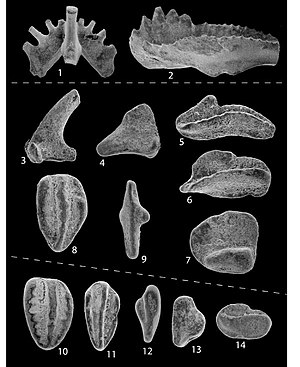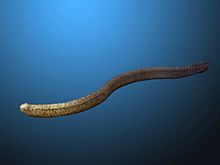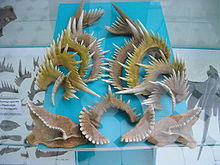Conodonts
| Conodonts | ||||||||||||
|---|---|---|---|---|---|---|---|---|---|---|---|---|

Selection of various conodont elements from the sub-Carboniferous Mauch-Chunk formation of Pennsylvania and Maryland , USA |
||||||||||||
| Temporal occurrence | ||||||||||||
| Cambrian to Upper Triassic | ||||||||||||
| 541 to 201.3 million years | ||||||||||||
| Locations | ||||||||||||
|
||||||||||||
| Systematics | ||||||||||||
|
||||||||||||
| Scientific name | ||||||||||||
| Conodonta | ||||||||||||
| Pander , 1856 |
The conodonts (Conodonta ( Gr . For "cone tooth")) are an extinct group of animals that lived in the sea without exception. Their characteristic fossil remains form one of the most important groups of microfossils . They were scientifically described for the first time in 1856 by Christian Heinrich Pander and are now mostly assigned to the chordates (chordata) or even the vertebrates (vertebrata).
The tooth-like hard parts of the head region of these animals, which together form what is known as the conodont apparatus, have been known as fossils since around 1850. But it was not until the 1980s and 90s that the first descriptions of the soft tissue anatomy of the "conodont animals" could be published after corresponding fossil remains had been discovered in rock samples from the area around Edinburgh and in the Soom shale in South Africa . Although over 3000 conodont species have been described so far and thus represent the most species-rich fossil group of the chordates, the soft bodies of almost all of these species are still unknown. The oldest conodonts come from early Cambrian sedimentary rocks that are around 542 million years old. The most recent are found in the 200 million year old deposits of the Upper Triassic. With the mass extinction at the Triassic-Jura border , the conodonts disappear from the fossil record .
Characteristics and paleobiology


According to what one believes to be able to deduce from the few soft body fossils, the conodonts had a lanceolate habitus with a laterally flattened body. The longest individuals likely reached up to 40 centimeters in length. Whether they lived in free water ( pelagic ) or partially or completely buried in the sediment ( endobenthic ) cannot be said from the fossils. Possibly an asymmetrical, hem-like caudal fin sat at the end of the body, which would speak for a free-swimming locomotion. The entire length of the body was traversed by a ribbon-like structure, which is interpreted as the notochord . V-shaped shadows in the soft body fossils could be muscle segments ( myomers ). The front end of the body ( "head") shows in some specimens from Scotland sweeping paired dark structures, which are interpreted as large sideways eyes and thus as an indication of a relatively high Zerebralisations grade, sophisticated visual perception and a way of life as active hunters. However, all of these interpretations are not without controversy. It is only indisputable that the conodontal apparatus was located in the area of the head, which certainly had a function in connection with food intake.
The conodont apparatus was made up of individual tooth-like mineral structures, the conodont elements. Before the discovery of soft body fossils, the term “conodonts” applied exclusively to these mineral elements, and even today these are often only meant when “conodonts” are spoken of, because they are usually the only ones that have been handed down in fossil form. These tooth-like elements are usually very small. With sizes of usually 0.1 to 2 millimeters, they belong to the microfossils. Few conodont elements with a size of more than 10 millimeters are known. They are composed of apatite with a low content of calcium carbonate ( non-stoichiometric empirical formula: Ca 5 Na 0.14 (PO 4 ) 3.01 (CO 3 ) 0.16 F 0.73 (H 2 O) 0.85 ).
Although the elements of the conodont apparatus show similarities in terms of their chemical composition with the teeth of the jaws , ie the "higher" vertebrates, this alone is not a reliable indication of an ancestral relationship between conodonts and vertebrates. This is because skeletal elements made of calcium phosphate occur in up to 19 different animal phyla , which are not closely related, especially in the Old Paleozoic . Although they are now also functionally interpreted as "teeth", they are not homologous to the teeth of the higher vertebrates : these emerged from the strongly mineralized, tooth-like scales of original jawless fish, as they still occur in a modified form in sharks today, while the conodonts are built much more originally and had no scales or similar external hard parts.
The elements of the conodontal apparatus, which are individually anchored in the soft tissue during lifetime, also show a growth mode that is fundamentally different from vertebrate teeth. In vertebrate animals the teeth are mainly in the tooth cavity, the pulp cavity, new layers of dentin attached to the inside of the tooth. The pulp cavity therefore becomes smaller and smaller with increasing age. Conodont elements do not have a pulp cavity. They grow by continuously adding new layers of apatite from the outside. In this way even fractures could "heal". The conodont elements therefore had to have been enclosed on all sides, at least periodically, by the soft tissue that had deposited the apatite. Otherwise it would not have been possible to add new, uninterrupted layers to the fractures. Such growth discontinuities were already observed in the 1930s and 40s with light microscopy on thin sections of isolated conodont elements.
meaning
stratigraphy
The very rapid change in shape and the resulting high temporal resolution as well as the amount of tiny conodont elements found make them very important key fossils in stratigraphy . Based on the fossils a very delicate division of was Palaeozoic as well as parts of the Mesozoic made because most species occurred only for very short periods in the earth Poche, because of their ( pelagic were widespread) lifestyle and their fossils in various sedimentary rocks occur ( Facies independence ).
Raw material geology
The conodont elements show an alternation of skeletal phosphate and organic matter inside. Due to high temperatures during diagenesis (sediment solidification due to the load of overlying rock layers), depending on the depth of the subsidence, the organic matter becomes carbonized and the originally cream-colored elements turn dark and are black at around 300 ° C. Even higher temperatures lead to a lightening again via various shades of gray. At 700 ° C the elements are completely white and often transparent. A seven-step color scale, the so-called Conodont Alterations Index (CAI) , is based on the temperature-dependent discoloration and is a measure of the thermal overprinting and the degree of metamorphosis of the rock. At high CAI values, no hydrocarbons were stable in the sediments for a certain period of time , so they cannot be storage rocks for crude oil . The discoloration of conodonts is therefore an important indicator when prospecting for oil and natural gas .
Systematics
Although the conodont elements have been known for a very long time, their systematic classification has always been controversial. Until the late 20th century, they were mostly placed in the vicinity of the articulated worms (Annelida). The thesis, already advocated by Christian Heinrich Pander in the 19th century, that conodonts are vertebrates , was given new food in 1982: The first finding was made when the British Euan Clarkson investigated samples of the sub-carbonic "Granton Shrimp Bed" collected in the Edinburgh district in 1925 of conodontents in soft tissue preservation. The flattened and relatively low-contrast remains of the soft body showed features that could be brought into agreement with those of primitive chordates ( lancet fish ). Clarkson published the findings and their interpretation together with two colleagues in 1983. This laid the foundation for today's prevailing doctrine that at least the "higher" conodonts (Euconodonta) with their complex jaw apparatus, which the Clydagnathus ? cf. cavusformis were assigned to certain pieces from the “Granton Shrimp Bed”, are primitive chorus dates . Similar finds from other regions of the world, especially from the Upper Ordovician Soom slate (Cederberg Formation) from South Africa ( Promissum pulchrum ) subsequently consolidated the thesis.
Some British paleontologists finally began conodonts as primitive vertebrates or even as home groups representatives of gnathostomes to consider. At least against the latter point of view, however, among other things, the complete absence of hard parts next to the jaw apparatus and the demonstrably convergent formation of the teeth in conodonts and gnathostomes (see also features ).
Others
The Pander Society is an association of conodont researchers.
literature
- Derek EG Briggs, Euan NK Clarkson, Richard J. Aldridge: The conodont animal. Lethaia. Vol. 16, No. 1, 1983, pp. 1-14
- Simon J. Knell: The Great Fossil Enigma. The Search for the Conodont Animal. Indiana University Press, Bloomington (Indiana), 2013, ISBN 978-0-253-00604-2
- Walter C. Sweet: The Conodonta: Morphology, Taxonomy, Paleoecology, and Evolutionary History of a Long-Extinct Animal Phylum. Oxford University Press, 1988
Web links
Single receipts
- ↑ Paul Selden, John Nudds: Window on Evolution - Famous Fossil Findings of the World (translated by Jens Seeling). Elsevier Spektrum Akademischer Verlag, Munich 2007, ISBN 978-3-8274-1771-8 , p. 29
- ^ Mark A. Purnell: Large eyes and vision in conodonts. Lethaia. Vol. 28, No. 2, 1995, pp. 187-188, doi: 10.1111 / j.1502-3931.1995.tb01612.x (alternative full-text access : ResearchGate )
- ^ A b Judith Wright: Conodont Apatite: Structure and Geochemistry. In: Joseph G. Carter (Ed.): Skeletal Biomineralization: Patterns, Processes and Evolutionary Trends. Short courses in geology. Vol. 5, 1989, pp. 149-163, doi : 10.1029 / SC005p0149 (alternative full-text access : American Geophysical Union )
- ↑ David Jones, Alistair R. Evans, Emily J. Rayfield, Karen KW Siu, Philip CJ Donoghue: Testing microstructural adaptation in the earliest dental tools. Biology Letters. Vol. 8, No. 6, 2012, pp. 952-955, doi : 10.1098 / rsbl.2012.0487
- ↑ Erik Cowing Katvala, Charles M. Henderson: Chemical element distributions within conodont elements and their functional implications. Paleobiology. Vol. 38, No. 3, 2012, pp. 447-458, doi : 10.1666 / 11038.1
- ^ Philip CJ Donoghue: Growth and patterning in the conodont skeleton. Philosophical Transactions of The Royal Society B. Vol. 353, No. 1368, 1998, pp. 633–666 doi: 10.1098 / rstb.1998.0231 (alternative full text access : ResearchGate )
- ↑ Christian Heinrich Pander: Monograph of the fossil fish of the Silurian system of the Russian-Baltic governorates. Book printing of the Imperial Academy of Sciences, St. Petersburg 1856 ( HathiTrust ).
- ↑ SE Gabbott, RJ Aldridge, NN Theron: A giant conodont with preserved muscle tissue from the Upper Ordovician of South Africa. Nature. Vol. 347, 1995, pp. 800-803, doi: 10.1038 / 374800a0 .
- ↑ Susan Turner, Carole J. Burrow, Hans-Peter Schultze, Alain Blieck, Wolf-Ernst Reif, Carl B. Rexroad, Pierre Bultynck, Godfrey S. Nowlan: False teeth: conodont-vertebrate phylogenetic relationships revisited. Geodiversitas. Vol. 32, No. 4, 2010, pp. 545-594, doi: 10.5252 / g2010n4a1 (alternative full text access : MNHN ).